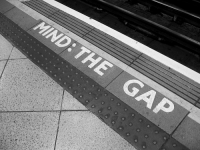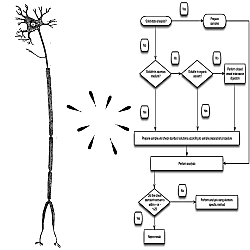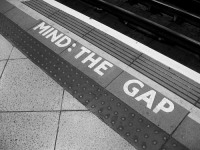 A better neurophysiology, the answer to the Hard Problem? Kirchhoff and Hutto propose a slightly different way forward.
A better neurophysiology, the answer to the Hard Problem? Kirchhoff and Hutto propose a slightly different way forward.
The Hard Problem, of course, is about reconciling the physical description of a conscious event with the way it feels from inside. This is the ‘explanatory gap’. Most of us these days are monists of one kind or another; we believe the world ultimately consists of one kind of thing, usually matter, without a second realm of spirits or other metaphysical entities on top. Some people would, accordingly seek to reduce the mental to the physical, perhaps even eliminating the mental so that our monism can be tidy ((I’m a messy monist myself). Neurophysiology, as formulated by Varela and briefly described in Kirchhoff and Hutto’s paper, does not look for a reduction, merely an explanation.
It does this by putting aside any idea of representations or computations; instead it proposes a practical research programme in which introspective reports of experience are matched with scans or other physical investigations. By elucidating the structure of both experience and physical event, the project aims to show how the two sides of experience constrain each other.
This, though, doesn’t seem enough for Kirchhoff and Hutto. Researching the two sides of the matter together is fine, but how will it ever show constraints, or generate an explanation? it seems it will be doomed to merely exhibiting correlation. Moreover, rather than resolving the explanatory gap, this approach seems to consolidate it.
These are reasonable objections, but I don’t think it’s quite as hopeless as that. The aspiration must surely be that the exploration comes together by exhibiting, not just correlation, but an underlying identity of structure? We might hope that the physical structure of the visual cortex tells us something about our colour space and visual experience that matches the structure of 0ur direct experience of colour, for example, in such a way that the mysterious quality of that experience is attenuated and eventually even dispelled. Other kinds of explanation might emerge. When I take off my glasses and look at the surface of brightly lit swimming pool, I see a host of white circles, all the same size and filled with the suggestion of a moire pattern, bobbing daintily about. In a pre-scientific era, this would have been hard to account for, but now I know it is entirely the result of some facts about the shape of my eyes and the lenses in them, and phenomenological worries don’t even get started. It could be that neurophilosophy can succeed in offering explanations good enough to remove the worries that currently exist. The great thing about it, of course, is that even if that hope is philosophically misplaced, elucidating the structure of experience from both ends is a very worthwhile project anyway, one that can surely only yield valuable new understanding.
However, what Kirchhoff and Hutto propose is that we go a little further and abolish the gap. Instead of affirming the separateness of the physical and the phenomenal, they suggest, we should recognise that they represent to different descriptions of a single thing.
That might seem a modest adjustment, but they also assert that the phenomenal character of experience actually arises not from the mere physics, but from the situation of that experience, taking place in an enactive, embodied context. So if we hold a book, we can see it; if we shut our eyes, we continue to feel it; but we also have a more complex engagement with it from our efforts to hold up what we know is a book, the feel of pages, and so on. There’s all sorts of stuff going on that isn’t the mere physical contact, and that’s what yields the character of the experience.
I see that, I think, but it’s a little odd. If we imagine floating in a sensory deprivation tank and gazing at a smooth, uniform red wall, we seem to be free of a lot of the context we’d normally have and on this view it’s a bit hard to see where the phenomenal intensity would be coming from (perhaps from the remembered significance of red?) We might suspect that Kirchhoff and Hutto are getting their phenomenal content smuggled in with the more complex phenomenal experience that they implicitly demand by requiring context, an illicit supplement that remains unexplained.
On this, why not let a thousand flowers grow; go ahead and develop explanations according to any exploratory project you prefer, and then we’ll have a look. Some of them might be good even if your underlying theory is wrong.
I think it is, incidentally. For me the explanatory gap is always misconstrued; the real gap is not between physics and phenomenology, it’s between theory and actuality, something that shouldn’t puzzle us, or at least not in the way it always does.


 One way of setting up the vexed question of qualia is to claim that there is an explanatory gap between what science tells us about our sensory organs and nervous system on the one hand, and actual real experience on the other. Nothing in the biological/physical story, it’s claimed, tells us what the redness of a rose or the smell of violets is actually like, and nothing of that kind ever could. The two aspects of the experience do not connect with each other. In the latest JCS, Michael Pauen sets out to show us that that supposed gap does not exist.
One way of setting up the vexed question of qualia is to claim that there is an explanatory gap between what science tells us about our sensory organs and nervous system on the one hand, and actual real experience on the other. Nothing in the biological/physical story, it’s claimed, tells us what the redness of a rose or the smell of violets is actually like, and nothing of that kind ever could. The two aspects of the experience do not connect with each other. In the latest JCS, Michael Pauen sets out to show us that that supposed gap does not exist.